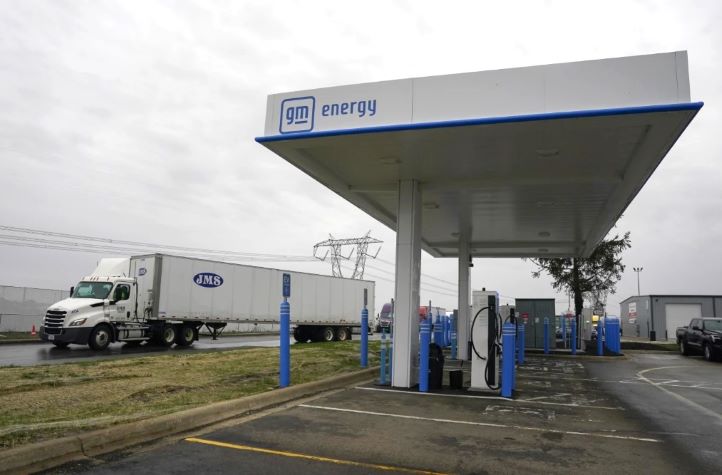LONDON, Ohio — At a Pilot Travel Center along Interstate 70, which opened in London, Ohio, in December with four chargers, passenger cars can charge up in about half an hour while drivers buy food and drinks and use amenities.
But for semis, that time can be more than that — sometimes around 90 minutes.
And charging stations are few and far between.
There are companies working to develop electric charging stations, such as the aforementioned Pilot. Love’s Truck Stops is working on electrification as well.
But a recent study, commissioned by the Clean Freight Coalition (CFC) and conducted by Roland Berger shows that full electrification of long-haul vehicles would require a $57 billion investment by fuel retailers to build out a sufficiently dense long-haul charging network.
To electrify all medium-and heavy-duty vehicles, fleets and charge point operators will need to invest $620 billion into chargers, site infrastructure and utility service costs, the study notes.
In addition, reports from the American Transportation Research Institute (ATRI) identify the many challenges facing commercial-vehicle electrification in the areas of U.S. electricity supply and demand, electric vehicle (EV) production and truck-charging requirements.
The Ohio charging station was created from the $5 billion National Electric Vehicle Infrastructure program, part of the bipartisan infrastructure bill President Joe Biden signed into law in November 2021. More than two years later, only four states — Ohio, New York, Pennsylvania and Hawaii — have opened stations funded by the program.
Biden, a Democrat, has set a goal of creating a national network of 500,000 publicly available chargers by 2030. Easily accessible charging ports are a key part of his effort to encourage drivers to move away from gasoline-powered cars and trucks that contribute to global warming.
That effort took on greater urgency this month as the Biden administration announced new automobile and commercial vehicle emissions standards that officials called the most ambitious plan ever to cut planet-warming pollution from passenger vehicles. Meeting those standards would require a huge increase in sales of EVs and plug-in hybrids.
EVs hit a record 1.19 million in sales in the U.S. last year and accounted for 7.6% of the total U.S. vehicle market, up from 5.8% in 2022.
Transportation emissions are the nation’s largest source of greenhouse gases.
The Biden administration says the federal charging program is on track. Several states, including Maine, Vermont and Colorado, are expected to open public charging stations later this year, while more than a dozen others have awarded contracts for projects or broken ground.
“We are building this national framework from scratch, partnering with states to set plans, and we want to make sure we are taking appropriate care to set this program up correctly,″ Federal Highway Administrator Shailen Bhatt said in an interview.
“The first two years were about getting the rules right, getting the plans in place,” Bhatt said. “And now what you’re going to see is this year being about the chargers coming online.”
As part of the national charging station rollout, the Biden administration awarded $623 million in grants to states, local governments and tribes in January. The grants will fund 47 EV charging stations and related projects in 22 states and Puerto Rico, including 7,500 charging ports.
Separately, Walmart and other private companies have pledged to build a network of affordable fast-charging stations for EVs. The federal program is also expected to serve as a catalyst for other projects.
“We’re committed to making sure that all Americans can charge (their EVs) where they live, work, shop, play, pray,″ said Gabe Klein, director of the Joint Office of Energy and Transportation, which runs the federal charging program.
But even some of the government’s own experts say 500,000 public chargers won’t be enough to meet Biden’s ambitious climate goals. The Department of Energy’s National Renewable Energy Laboratory estimated last year that the U.S. will need 1.2 million public chargers by 2030, a huge jump from the 175,00 public charging ports now available, as measured by the Alternative Fuels Data Center, a division of the Energy Department.
The availability of charging stations is key to persuading Americans to buy EVs.
Driving range anxiety is still an impediment, along with cost. About 80% of respondents cited concerns about a lack of charging stations as a reason not to buy an electric vehicle, according to a 2023 survey from The Associated Press-NORC Center for Public Affairs Research and the Energy Policy Institute at the University of Chicago.
Seven in 10 said they would not buy an EV because it takes too long to charge and the battery technology isn’t ready.
In some parts of the country — especially rural areas far from major cities — “there are definitely corridors where you have worries about range anxiety,’’ Bhatt said. “It is going to take longer to get to them, just like it took longer to get cellphone coverage in those places.’’
But he said the administration’s goal is to have chargers every 50 miles (80 kilometers) along U.S. interstates. Other major charging networks offered by Tesla, EVgo and Electrify America prioritize shopping centers, gas stations and grocery stores, but long-distance travel is where many Americans perceive the biggest gap.
As Biden doubles down on clean energy as part of his reelection campaign, it’s notable that Ohio, a swing state led by Republican Gov. Mike DeWine, was one of the first movers in the federal charging endeavor.
“Electric vehicles are the future of transportation, and we want drivers in Ohio to have access to this technology today,” said DeWine, who appeared at the Ohio station’s grand opening in December.
A state Department of Transportation program, DriveOhio, served as the charging station’s organizational structure. A public-private partnership authority helped supply money needed for the project after the federal program contributed 80% of the estimated $500,000 to $750,000 cost, including buildout, operation and maintenance for five years.
“I actually don’t think these are moving very slow. I think they’re going really quickly given that they’re tiny construction projects that we’re deploying at a pretty significant scale,” said Preeti Choudhary, DriveOhio’s executive director. “Getting them in the ground quickly is important because we do have this growing contingency of EV drivers out there and they need to be supported when they’re driving across our state or across the country.”
Meeting federal requirements and operating standards is a challenge for states with little experience rolling out this type of infrastructure, according to Loren McDonald, an independent analyst tracking the buildout.
“The states are moving at very different speeds,” he said. “It might take a good 18 months on average for a lot of these stations to come online.’’
Projects can be held up for months to years by delays with permitting, approvals, electrical upgrades and equipment. The latter can be costly. In California, the state with the most electric cars, its Public Utilities Commission could spend $50 billion through 2035 just to meet demand there.
The Trucker News Staff contributed to this report.
The Associated Press is an independent global news organization dedicated to factual reporting. Founded in 1846, AP today remains the most trusted source of fast, accurate, unbiased news in all formats and the essential provider of the technology and services vital to the news business. The Trucker Media Group is subscriber of The Associated Press has been granted the license to use this content on TheTrucker.com and The Trucker newspaper in accordance with its Content License Agreement with The Associated Press.








